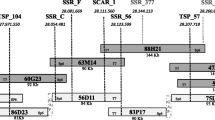Summary
Beta procumbens-specific DNA probes have been constructed by cloning digested total DNA in E. coli and screening the resulting recombinant plasmids in dot blot hybridizations with labelled B. procumbens and B. vulgaris DNA. Four clones (pTS1-4) have been analyzed in detail determining their degree of specificity and DNA sequence. Two clones (pTS1 and pTS2) with the highest degree of B. procumbens specificity were adapted for the squash dot hybridization with the aim of screening large numbers of individual hybrid plants (B. vulgaris x B. procumbens) carrying an alien B. procumbens chromosome (2n = 19). These addition lines carry in some cases B. procumbens resistance genes to the beet cyst nematode (Heterodea schachtii Schm.).
Similar content being viewed by others
References
Ananiev EV, Bochkanov SS, Ryzhic MV, Sonina NV, Chernyshev AI, Schipkova NI (1986) Cross-hybridization of cloned repeated sequences of barley genome with DNAs from wheat, rye and maize. Genetika 22:2021–2025
Bedbrook IR, Jones I, O'Dell M, Thompson RD, Flavell RB (1980) A molecular description of telomeric heterochromatin in Secale species. Cell 19:545–560
Birnboim HC, Doly J (1979) A rapid alkaline extraction procedure for screening recombinant plasmid DNA. Nucleic Acids Res 14:1513–1523
De Jong JH (1981) Investigations into chromosome morphology and related wild species. Kulturpflanze 29:353–360
Flavell RB, Bennett MD, Smith JB, Smith OB (1974) Genome size and the proportion of repeated nucleotide sequence DNA in plants. Biochem Genet 12:257–269
Grellet F, Delcasso D, Panabieres F, Delseny M (1986) Organization and evolution of a higher plant alphoid-like satellite DNA sequence. J Mol Biol 187:495–507
Grellett F, Tremousaygue D, Delseny M (1988) Isolation and characterization of a tandemly repeated DNA sequence from the Crucifer Sisymbrum irio. Indian J Biochem Biophys 25:483–487
Hallden C, Bryngelsson T, Gustafsson M (1987) Distribution and evolution of a tantemly repeated DNA sequence in the family Brassicaceae. J Mol Evol 25:318–323
Hanahan D, Meselson M (1980) A protocol for high density screening of plasmids in 1776. Gene 10:673–677
Hutchinson J, Londsdale DM (1982) The chromosomal distribution of cloned highly repetitive sequences from hexaploid wheat. Heredity 48:371–376
Hutchinson J, Abbott A, O'Dell M, Flavell RB (1985) A rapid screening technique for the detection of repeated DNA sequences in plant tissues. Theor Appl Genet 69:329–333
Jung C, Wehling P, Löptien H (1986) Electrophoretic investigations on nematode-resistant sugar beets. Plant Breed 97:39–45
Junghans H, Metzlaff MA (1988) Genome-specific, highly repeated sequences of Hordeum vulgare: cloning, sequencing and squash dot test. Theor Appl Genet 76:728–732
Maniatis T, Fritsch EF, Sambrock J (1982) Molecular cloning: a laboratory manual. Cold Spring Harbor Laboraty Press, Cold Spring Harbor/NY
Metzlaff M, Tröbner W, Baldauf F, Schlegel R, Cullum J (1986) Wheat-specific repetitive DNA sequences —construction and characterization of four different genomic clones. Theor Appl Genet 72:207–210
Raeder U, Broda P (1984) Comparision of the lignin degrading white rot fungi Phanerochate orysosporium and Sporo-trichum pulverutentum at the DNA level. Curr Genet 8:499–506
Sanger F, Coulson AR, Barrell BG, Smith AJH, Roe BA (1980) Cloning in single-stranded bacteriophage as an aid to rapid DNA sequencing. J Mol Biol 143:161–178
Savitzky H (1978) Nematode (Heterodea schachtii) resistance and meiosis in diploid plants from interspecific Beta vulgaris x B. procumbens hybrids. Can J Genet Cytol 20:177–186
Southern EM (1975) Detection of specific sequences among DNA fragments separated by gel electrophoresis. J Mol Biol 98:503–518
Van Geyt JPC, Smed E (1984) Polymorphism of some marker enzymes of the sugar beet (Beta vulgaris L.) investigated by polyacrylamid gel electrophoresis and starch gel electrophoresis. Z Pflanzenzucht 92:295–308
Van Geyt JPC, Oleo M, Lange W, De Bock TSM (1988) Monosomic additions in beet (Beta vulgaris) carrying extra chromosomes of Beta procumbens. 1. Identification of the alien chromosomes with the help of isozyme markers. Theor Appl Genet 76:577–586
Wienand U, Feix G (1980) Zein specific restriction enzyme fragments of maize DNA. FEBS Lett 116:14–16
Author information
Authors and Affiliations
Additional information
Communicated by G. Wenzel
Rights and permissions
About this article
Cite this article
Schmidt, T., Junghans, H. & Metzlaff, M. Construction of Beta procumbens-specific DNA probes and their application for the screening of B. vulgaris x B. procumbens (2n = 19) addition lines. Theoret. Appl. Genetics 79, 177–181 (1990). https://doi.org/10.1007/BF00225948
Received:
Accepted:
Issue Date:
DOI: https://doi.org/10.1007/BF00225948




